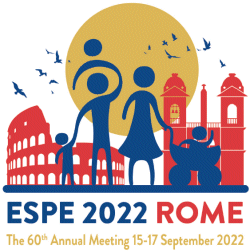
60th Annual ESPE (ESPE 2022)
Rome,
Italy
15 Sep 2022 - 17 Sep 2022
Rapid Free Communications
GH and IGFs
hrp0095rfc10.1 | GH and IGFs | ESPE2022
Clinical and biochemical predictors of Permanent Growth Hormone Deficiency (PGHD) at retesting
Petraroli Maddalena , Messina Giulia , Gnocchi Margherita , Lattanzi Claudia , D'Alvano Tiziana , Argentiero Alberto , Neglia Cosimo , Dora Patianna Viviana , Maria Roberta Esposito Susanna , Elisabeth Street Maria
hrp0095rfc10.2 | GH and IGFs | ESPE2022
Severe primary IGF1 deficiency diagnosed by a standardized IGF1/ IGFBP3 generation test : the Belgian experience
Ryckx Sofie , Derycke Christine , Anckaert Ellen , Beauloye Véronique , Beckers Dominique , Brachet Cécile , Den Brinker Marieke , De Waele Kathleen , Dotremont Hilde , Boros Emese , Klink Daniel , Lebrethon Marie-Christine , Lysy Philippe , Mouraux Thierry , Parent Anne-Simone , Rochtus Ann , van der Straaten Saskia , De Schepper Jean
hrp0095rfc10.3 | GH and IGFs | ESPE2022
A rare HESX1 variant in a patient with congenital hypopituitarism
Anastasia Ibba , Paraluppi Valentina , Lussu Anna , Guzzetti Chiara , Casula Letizia , Loche Sandro
hrp0095rfc10.4 | GH and IGFs | ESPE2022
Recombinant PAPP-A2 induces sex-specific increases in body weight and length and changes in bone microstructure in adolescent mice with longitudinal growth reduction induced by Pappa2 deletion
del Mar Fernández-Arjona María , Rubio Leticia , López-Gambero Antonio , Rivera Patricia , Vargas Antonio , Rodríguez de Fonseca Fernando , A. Chowen Julie , Argente Jesús , Suárez Juan
hrp0095rfc10.5 | GH and IGFs | ESPE2022
Evaluation of health-related quality of life & problem behavior in adults born small for gestational age treated with growth hormone during childhood in comparison with untreated controls
Dorrepaal Demi , Wesley Goedegebuure , der Steen Manouk van , Anita Hokken-Koelega
hrp0095rfc10.6 | GH and IGFs | ESPE2022
Growth Hormone Deficiency in Adult Survivors of Childhood Brain Tumors Treated with Irradiation
Marie Baunsgaard Mette , Sophie Lind Helligsoe Anne , Tram Henriksen Louise , Stamm Mikkelsen Torben , Callesen Michael , Weber Britta , Hasle Henrik , Birkebæk Niels



